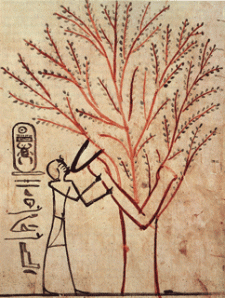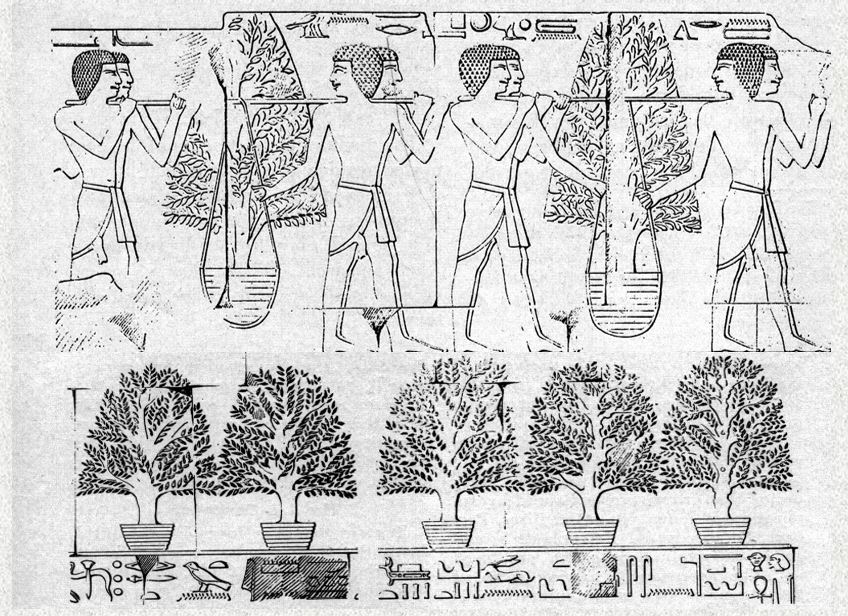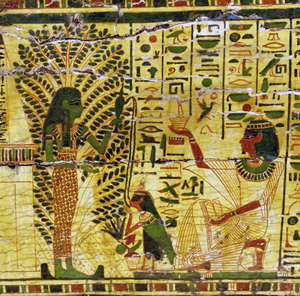
Do you have a tree in your house right now?
Many of us do.
Each winter, we celebrate the winter holidays by bringing evergreen trees into our homes, decorating them with shiny ornaments and glittering lights. The rather obvious reason for this is to remind ourselves of the green life that exists even in this darkest part of the year when most plant life has either died off or gone into hibernation—as well as to celebrate that ongoing life with our beloved ones and to prepare for the next phase of life in the coming New Year.
Trees, of course, were important to the ancient Egyptians as well—both symbolically and practically—though they were not the type of evergreen conifers we generally have as Yule trees. (There is only one conifer native to Egypt, a type of juniper; but they had access to other conifers and coniferous resins by importing them.)
I’m not sure whether ancient Egyptians brought cut or potted trees into their homes during festivals like we do. But we know they brought in branches and flowers for certain festivals. We know that temples, palaces, and well-to-do homes had extensive gardens and that beautiful bouquets of flowers were ubiquitous as offerings to the Deities. We know that the ancient Egyptians transported trees in pots. The image here shows men bringing potted frankincense trees from their native land back to Egypt.
With their blessed shade, precious building material, and in the case of fruit trees, abundant food, trees were vitally important in ancient Egypt. They were, in fact, sacred and under the protection of the Tree Goddess. When we see images of the Tree Goddess, usually in funerary scenes, Her legs often disappear into the trunk of the tree, while Her hands offer food and water. Sometimes we see Her whole body in front of the tree; other times She is abstracted as offering arms or a nurturing breast. The most important of the Egyptian Tree Goddesses are Hathor, Nuet, and Isis.
On a funerary stele of an Egyptian official and his wife, Djehutihotep and Kayay, we see a potted, leafless tree. The pot looks decorative, perhaps painted with horizontal stripes or wrapped in offering fillets. Out of its branches arises the Tree Goddess giving food and water. She wears the throne of Isis upon Her head. Behind Her, an inscription reads, “she gives water as is right.” We can see the water flowing to Djehutihotep and Kayay. Interestingly, another inscription on the stele names Hathor while yet another asks Osiris, Horus, and Isis to give the couple bread and beer, air, water, incense, and all things good and pure.
Surely this stele invokes blessings similar to our Yule tree: ongoing life and sustenance in a place of darkness; in this case, the land of the dead. The epithet by which the Tree Goddess is called, Nebet Amentet, Lady of the West, means that She rules the place of the dead, euphemistically called The West, for it is in the west that the sun daily sets and enters the otherworld.

Nebet Amentet is an epithet common to both Isis and Hathor, so perhaps, with its mixed names and symbolism, both Goddesses are intended on this stele. (More often, though, it is Hathor Who is the Goddess of the leafless tree, which other texts identify as the Southern Sycamore, though this particular representation does not look like other sycamores in Egyptian art.)
Still, there are a number of representations of Isis as the Lady of the Sycamore and we know that She, too, is called by that epithet. A pillar in the tomb of Sennefer of Thebes (18th dynasty) shows Sennefer and his wife Meryt as they stand before a leafy tree, as sycamores are usually shown, with a Goddess figure in it Who is identified in the hieroglyphic text as Isis.
A 19th dynasty stele shows “Isis the Great, the God’s Mother” as a Tree Goddess Who extends Her breast toward the souls of the man and woman standing at Her roots.

The image you see here is another instance of the nourishing Tree Goddess Isis simply represented as a tree with an arm and a breast.
While the sacred tree is most often a sycamore, other Egyptian sacred trees—the acacia, persea, and date palm—could also be associated with Isis. Isis and Nephthys are called the Two Acacia Goddesses; and sometimes, the tree that grew up around the body of Osiris is said to have been an acacia, though other texts name other trees, such as the tamerisk. The Djed pillar of Osiris can also be seen as a stylized tree, sometimes with the two eyes of the God peering out.
According to Plutarch, the persea tree (Egyptian ished) is sacred to Isis “because its fruit is like a heart and its leaf like a tongue.” He explains that this is because no human quality is more Divine than reason, symbolized by the tongue, and that there is no more driving human force than happiness, symbolized by the heart.
During the Ptolemaic period, we have records of a grove of persea trees and an altar being dedicated to Isis, Osiris, Serapis, and Anubis by a specific thiasos (a private religious group, similar to a coven or circle today). At Isis’ temple at Philae, a graffito from one of the people who worked at the temple noted that he had planted a sacred tree in Her temple there, as well as three others in and around the nearby town.
Isis is associated with the palm tree through Her assimilation with Seshat, the Scribe & Writing Goddess, for one of Seshat’s symbols is the notched palm branch that was used to count time. In a later period, initiates of the Mysteries of Isis used the palm branch as a symbol of their rebirth.
And so this year as you honor the season with your Yule tree, perhaps it would be well to say a prayer to the Tree Goddess Isis and acknowledge Her Divinity in this beautiful symbol of ongoing green life. While the type of tree is not the same, the meaning is: She goes on and we go on—in spite of everything.

A beautiful image of the Tree Goddesses in the starry winter night






